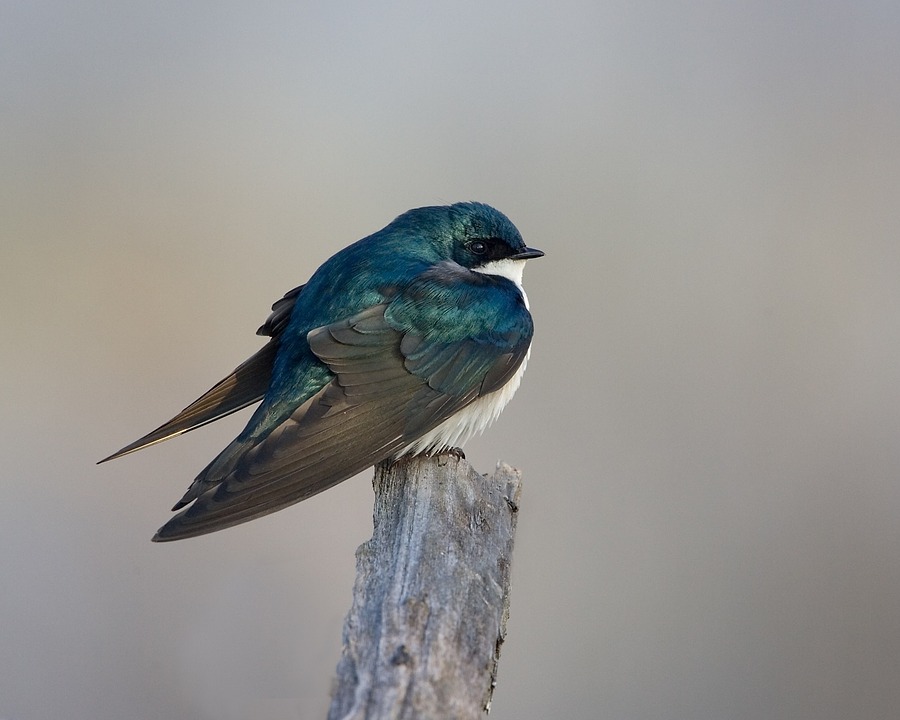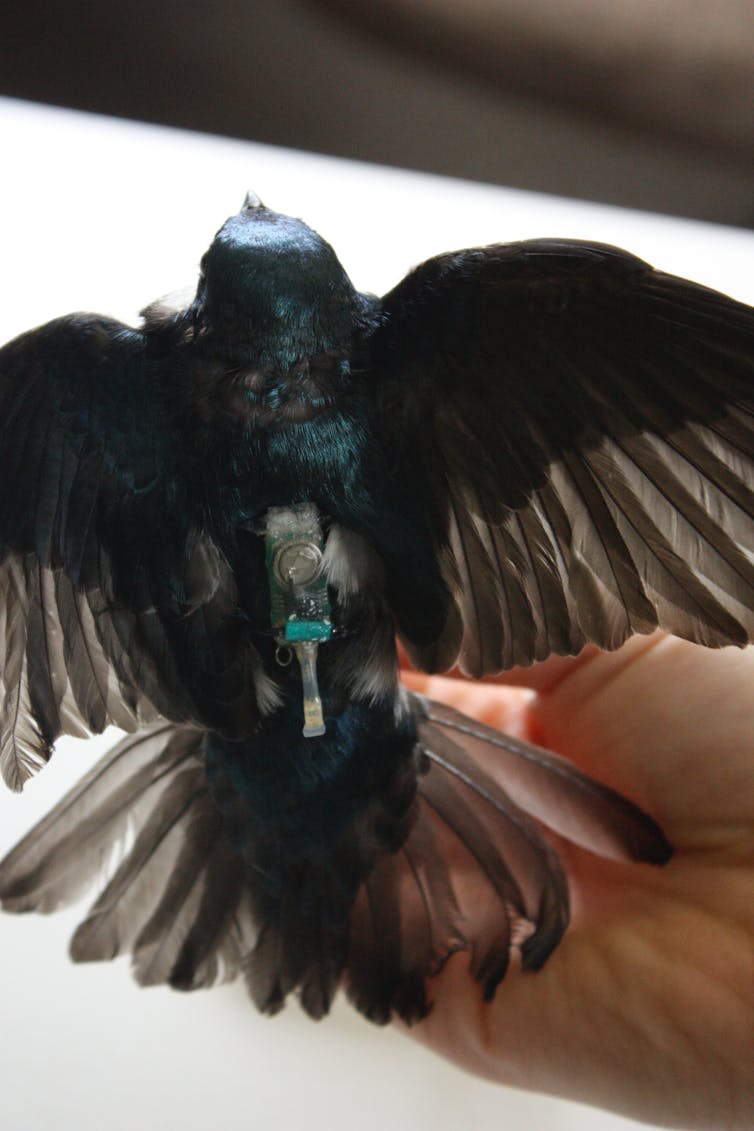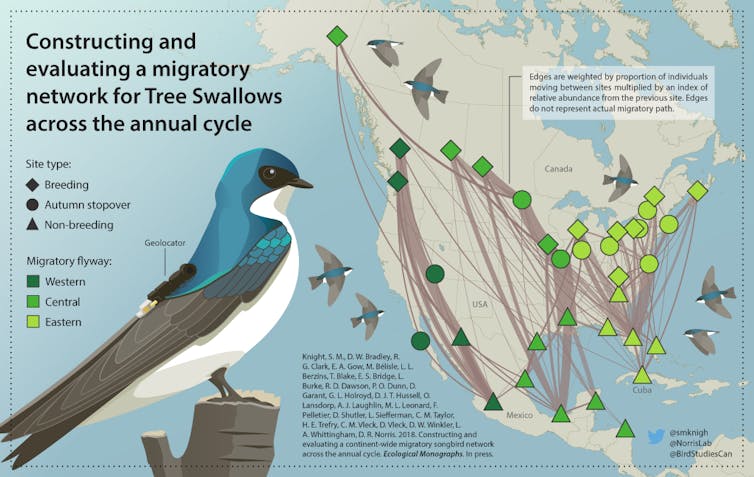This article was originally published on The Conversation and got picked up by the National Post and CBC News.

With the arrival of spring, we look forward to the return of hundreds of species of migratory songbirds from their wintering grounds.
Sparrows, swallows, warblers and thrushes, among other songbirds, will return from their wintering sites anywhere between the southern United States and distant South America.
Some of these birds will return with a small “backpack” that has recorded their entire migration from their North American breeding grounds to their wintering grounds and back.
Birds provide important ecosystem services, such as preying on insects, dispersing seeds, scavenging carcasses and pollinating plants. Unfortunately, there have been dramatic declines in many migratory songbirds over the past few decades, with some of these populations dropping by more than 80 per cent.
Read more:
How the hard work of wild animals benefits us too
If we are to find ways to slow or reverse these declines, we must first figure out what’s causing them. Climate change, habitat loss and predation by cats are among the leading causes of bird declines.
But with the vast distances these birds move over the course of the year, it can be difficult to pinpoint the main cause for a given species — and where it’s occurring.
Migratory connections
To answer this question, we need to know where individual birds spend their time throughout the year.
We have a good idea of the range — or the total area — the birds occupy during the breeding and wintering periods. But ranges are composed of many populations, and we still have a very poor understanding of how individuals within each of these populations are connected between seasons.
Individuals from different breeding populations may remain segregated during the winter. For example, some ovenbirds winter in the Caribbean whereas others spend their winters in Mexico and Central America.
Or a bird may mix with individuals that originate from other breeding populations, such as bobolinks that mix in South America during the winter.
These patterns of migratory connectivity have critical implications for predicting how migratory songbirds will respond to environmental change.
Habitat loss — deforestation, for example — in one place can have different effects. If habitat loss occurs in a wintering area where breeding populations mix, it may have wide-ranging, yet diffuse, effects on the breeding populations. But if the habitat loss occurs in a wintering area that is occupied by a single breeding population, the effect may be more focused.
For example, habitat loss in South America will likely have range-wide effects on bobolinks, while habitat loss in the Caribbean may only influence a portion of the breeding populations of ovenbirds.
Backpacks for birds
We know that the breeding and wintering populations of most species mix to some extent, but we don’t know by how much or where in the range that occurs. By understanding the migratory network, we can predict how populations across the range will respond to future changes in the environment.
How do we determine where particular individuals go? This is where the tracking “backpacks” come in handy.
These devices, known as “archival light-level geolocators,” weigh less than one gram and are small enough to be carried by songbirds.

Geolocators record ambient light levels every few minutes while in use. We can then use the geographic variation in sunrise and sunset times as well as day length to locate the individual bird.
We can figure out the bird’s longitude — its east-west position — by comparing solar noon, the midway point between sunrise and sunset, with the time of day (using Greenwich Mean Time). We calculate its latitude — its north-south position — from day length.
Each backpack provides a year’s worth of daily light levels, and a glimpse into one bird’s annual journey.
Tracking tree swallows
In 2011, we began deploying geolocators on tree swallows at 12 sites across their breeding range, from Alaska to Nova Scotia and North Carolina.
These iridescent blue birds with bright white bellies can be seen foraging for flying insects in marshes and fields across Canada and the United States in the spring and early summer. Like many migratory songbirds, tree swallows are experiencing population declines in parts of their breeding range. It is unclear what is driving these declines. However, they coincide with declines in several species of birds that also feed on aerial insects.
By 2015, our team, comprising 27 collaborators, had retrieved more than 140 of these devices. We tracked these birds from the breeding sites to their wintering grounds in Mexico, Central America, Florida and the Caribbean.
With this information, we developed the most comprehensive songbird migration map to date. We found evidence for a high degree of mixing within three distinct migratory flyways between the breeding and wintering grounds of tree swallows.
The tree swallow network
When we analyzed the network, we discovered that tree swallows migrated between their breeding and wintering grounds using three distinct migratory flyways: west of the Rocky Mountains, down the Mississippi River valley and along the Atlantic coast. Breeding populations within these flyways mixed extensively with one another at migration stopover and wintering regions.
We identified important regions within these flyways, such as areas in Florida, Louisiana, North Dakota, South Dakota and the U.S. Midwest, where tree swallows from many different breeding populations congregate. Such areas appear as critical connections within the whole network.
Now that we know more about the connections between breeding and wintering tree swallow populations, we can use this information to investigate threats to declining populations across their range. For example, using chemical markers, range-wide connectivity has been described in eastern North American monarch butterflies and then used to identify the primary threats in this declining population.
![]() This spring, as the migratory songbirds return, take a moment to think about the amazing journey these birds have taken since last autumn — while wearing their backpacks.
This spring, as the migratory songbirds return, take a moment to think about the amazing journey these birds have taken since last autumn — while wearing their backpacks.
